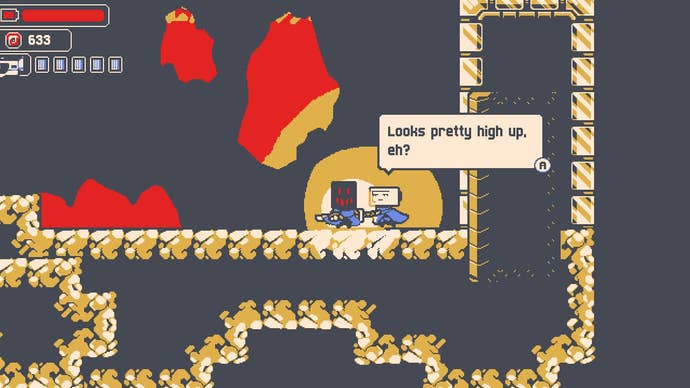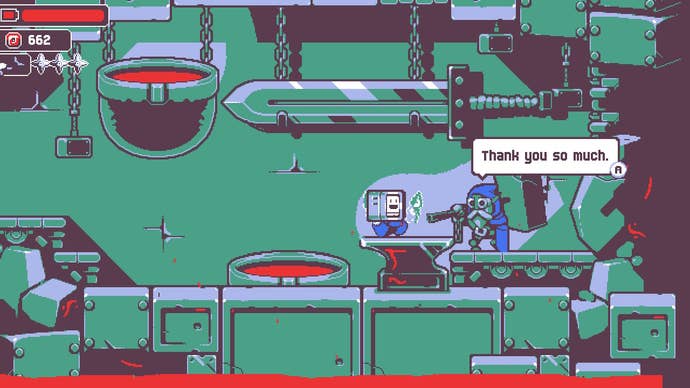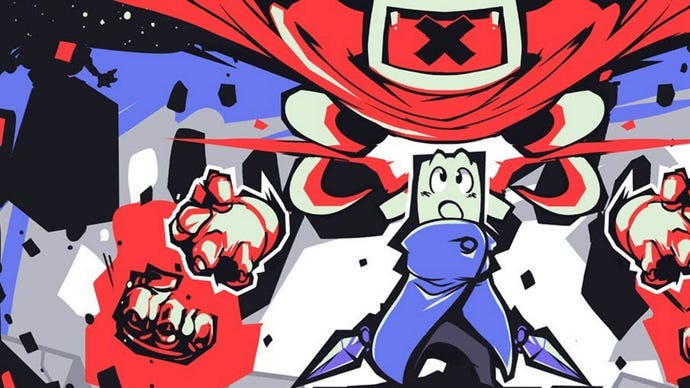Kunai Review: This Game Boy is Real Good at Swinging
Get into the swing of things with this ninja-flavored indie.
This article first appeared on USgamer, a partner publication of VG247. Some content, such as this article, has been migrated to VG247 for posterity after USgamer's closure - but it has not been edited or further vetted by the VG247 team.
There's something magnetic about swinging in video games. I remember the first time I played Bionic Commando on the NES, I was more concerned with swinging than actually playing the rest of the game. (I don't think I've beaten the original Bionic Commando.) Perhaps it's because we're hardwired to understand concepts like the fulcrum or momentum. It's fun to watch your character slam their face into a wall, only to find yourself swinging from platform to platform with ease hours later. Swinging is easy to understand, but it feels amazing when you master it.
Above all else, Kunai is about mastering your swing. You begin the game as Tabby, the silent automaton with a tablet for face, in midst of the apocalypse. Humanity is dead, and only robots remain. A cadre of robots resisting the leading regime have woken you up, and sent you on your way with only a katana in tow.
The opening hours of Kunai are entirely straightforward: wander about the side-scrolling map, dispatching enemies with your katana. You can see the hints and hallmarks of the Metroidvania genre, with roadblocks littering your path that will obviously be cleared once you have more abilities. There's a fluidity to the movement and controls that reminds me of Dead Cells or Hollow Knight; not every indie nails the precision needed for great 2D platforming, but the folks behind Kunai did. It's one of those games where I just picked it up and it immediately felt great to play.
The starting katana also highlights the versatility of Kunai's weapon design. It's your primary method of attack throughout the entire game, allowing you to slash left and right or upwards. The katana is vampiric, and heals you with a bit of the enemy's bleeding life force. It's a shield too, deflecting bullets back at enemies. You can also use it to get around, as a downward slash while jumping gives you a little hop if it connects with an enemy.
Once you collect the eponymous Kunai though, the hook of the game becomes clear. You have two kunai, each deployed through the triggers on the Nintendo Switch. The kunai have ropes tethering them to you, and when they find purchase in the right wall, you begin swinging. Where you tether in the middle of your jump, and where you release determines the direction Tabby is sent flying. You can deploy both tethers to simply hang in place, and eventually fling yourself upwards from a hanging position. You can even just pull yourself upwards, like a grappling hook. It's immediately intuitive and damned fun.

Kunai does not play around with swinging. At some point in the game, you will have to master the mechanic to move forward. Somewhere in the third or fourth area, it starts throwing longer stretches of rooms where you'll have to swing, dodge obstacles, and dispatch enemies as you explore. One boss fight atop a mountain is a straight skill check: if you can't swing, you can't hang with Kunai. I admit that I was angrily muttering under my breath as I finally dispatched that boss.
As you progress you'll gain other weapons and skills that open new paths, though Kunai feels a bit more linear compared to some other Metroidvania titles. You will backtrack, but there are few major branches away from the main path. Yes, there are secrets, but not whole new sections of the map. I would've liked a few more departures from the main path, but I understand that an indie dev can only do so much with the resources they have.
The other weapons you gain to open these paths mirror the katana, having multiple uses. The Shuriken can be used to power certain switches, but also stuns enemies. The Rocket Launcher is… a rocket launcher, but it can be used to destroy boulders and there's even a rocket jump. You can tell a lot of thought was put into every weapon you get, and they add up to an adaptable arsenal even with relatively few weapons overall. Eventually, I was sprinting through areas, switching between weapons fluidly so as to not break my stride, a robotic whirlwind of destruction. The flow here isn't as sublime as Dead Cells, but it gets there in some moments.

Visually, Kunai leans on the idea of less is more. The sprites have a Metal Slug feel to them: they look weighty, but also remarkably fluid in motion. Tabby is a joy to watch as his tablet face animates in a host of gleeful faces depending on what you're doing. Many of the enemy and NPC designs, like one blacksmith you meet later, are quite distinct.
I want to highlight Kunai's use of color as well. The game looks to be drawing on the simple color palettes of the Game Boy Color; almost monochrome, but not quite. For original Game Boy games, the Game Boy Color had a set of color palettes you could switch between and each palette would rely heavily on a single color. Kunai does the same, but splits the color focus depending on which region you're in. That means the Shuriken Shrine might rely heavily on greens, while the Zen Mountains are cast in a bright yellow. It's something you won't notice until you really dig into Kunai, but it gives the games its own unique style.
I do have some small issues with Kunai though. Occasionally, I'd simply forget where I was going, because the only indicator is a vague question mark if you're on the right map. Kunai lacks any sort of fast travel system, so eventually any small amount of backtracking becomes a bit of a mire; I kept expecting to unlock one, but it never happened.
But overall, it was an enjoyable experience while it lasted. It's not a total cakewalk in terms of difficulty, so expect to die and occasionally run into spots where only precision play will see you through. But this little indie game plays wonderfully and looks fantastic. I wish it was a little longer, but that means it didn't overstay its welcome and was absolutely worth my time.
ConclusionIndie games in the Metroidvania genre are pretty common, but Kunai manages to stands out with exceptionally fluid combat, a wonderful Game Boy Color aesthetic, and swinging around on your kunai. The swinging mechanic is the star of the show here, even if the design of your limited arsenal shows some clear thought went into making every weapon meaningful. Unfortunately, it can be difficult to figure out where you're supposed to go at times, backtracking in Kunai is a bit of a pain, and the level design doesn't offer as many branching paths as its competition. But it's worth playing through the game's short runtime and this is a great foundation for a sequel.


